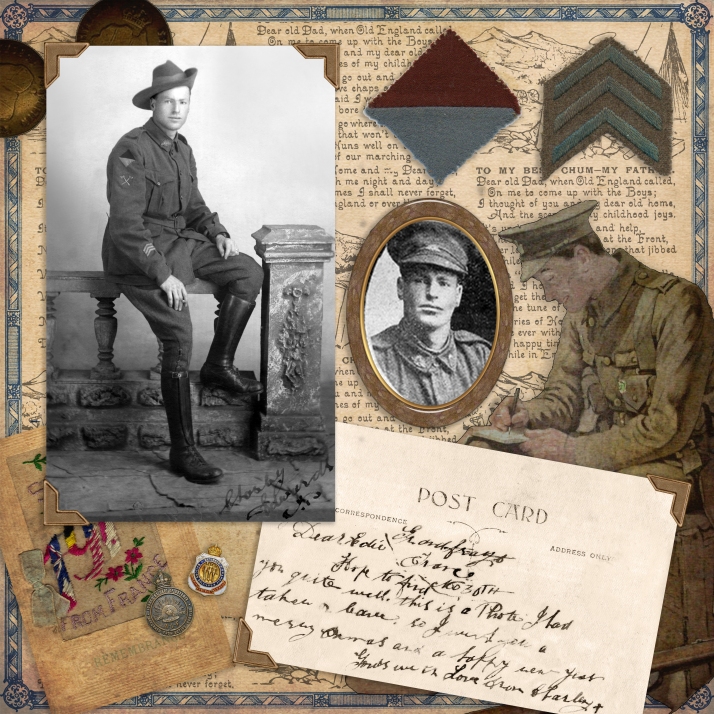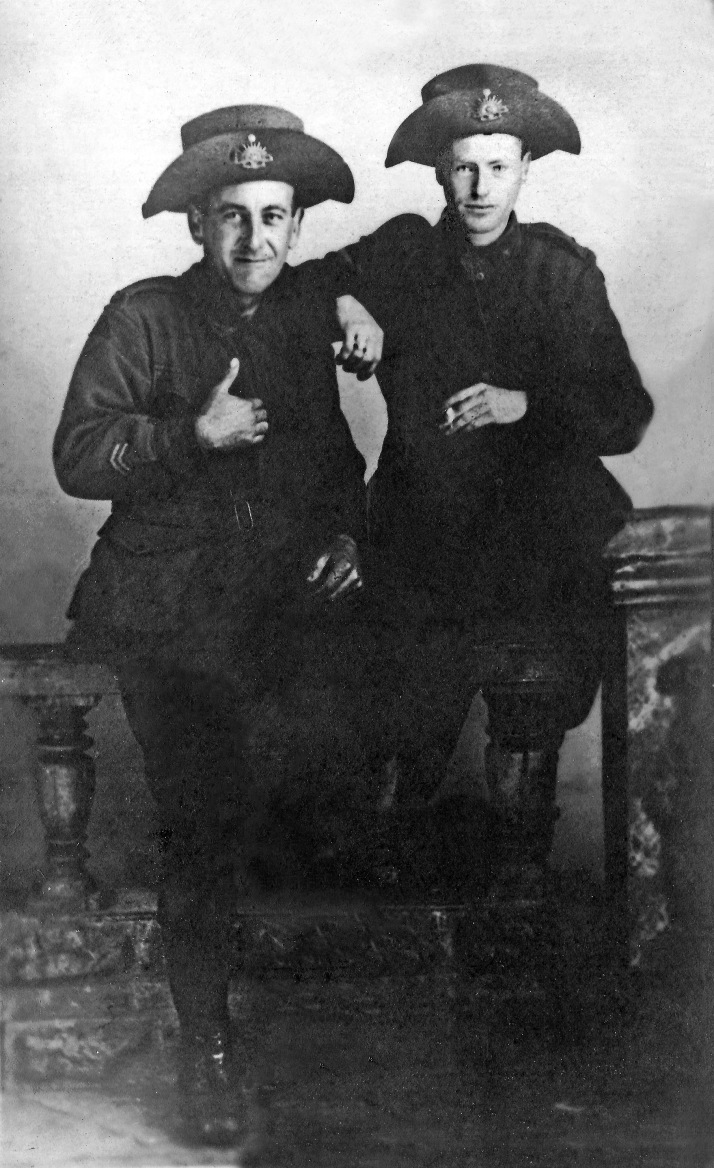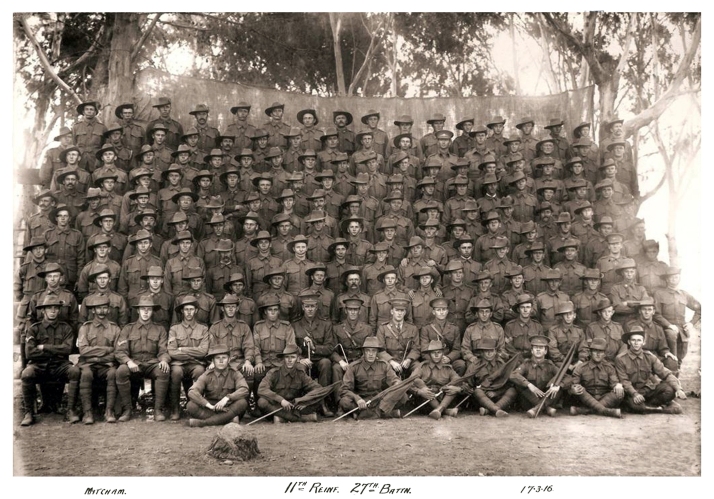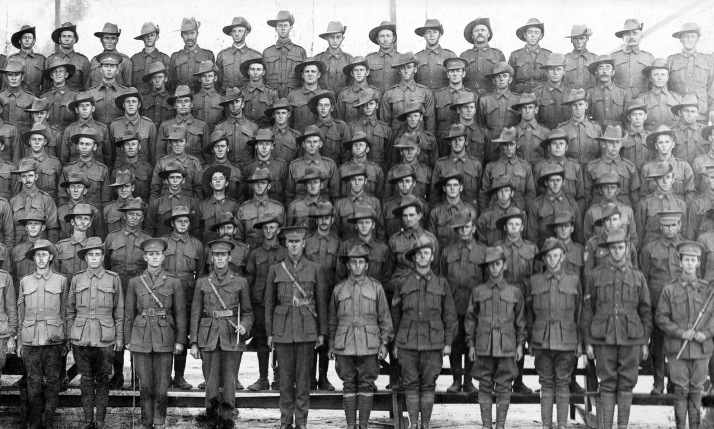This is my Mum’s father Henry Charles Jasper Edwards.
Henry Charles Jasper EDWARDS, son of William Henry EDWARDS and Ellen WILLIAMS, was born on Saturday, 2 March 1889 in Reedbeds, Adelaide, South Australia and died on Wednesday, 30 December 1959, aged 70, in Hampstead Repatriation Hospital, Adelaide, South Australia. Charley was educated at Handorf Public School, South Australia and was a Carpenter. He was buried in Centennial Park Cemetery, Adelaide, South Australia (Derrick Gardens Road 11 Path: 15 Site: 374)
Charley, aged 33, married Edith Alison MORRIS, aged 32, on Saturday, 29 July 1922, in Parsonage, South Terrace, Adelaide, South Australia and they had six children. Edith, daughter of William MORRIS and Alison Ann MUIRHEAD, was born on Friday, 18 April 1890 in Tam O’Shanter Belt, Adelaide, South Australia and died of Cancer on Monday, 5 April 1971, aged 80, in Glenelg, Adelaide, South Australia. She was cremated at Centennial Park Cemetery, Adelaide, South Australia (Painter Court Walls Row: W Path: 201 Site: G005)
1916
Charley joined the Army in WW1 on 7 January 1916, Regimental number 4414. His unit, 27th Battalion, 11th Reinforcement, embarked from Adelaide, South Australia, on board HMAT A9 Shropshire on 25 March 1916. He left Folkstone, England for France aboard the SS ‘Victoria’ on 15 December 1916 and arrived at Etaples, France where he began his training in an army camp on the coast.
He joined the 27th Battalion from 11th Reinforcements on 18 December 1916 in France, Somme, near Montauban. They left Vignacourt by train for Buire on the 19th where they were billeted. On the 22nd they marched out at 9.30am heading for Fricourt arriving at 1pm. They moved to the Melbourne Camp in Montauban on the 24th where they stayed in mission huts, the mud in the camp was extremely bad. Christmas day was bitterly cold and wet, it wasn’t celebrated at all; the men were sent out in working parties to lay cable. The mud is so bad some of the men have ‘trench feet’.
1917
They spent January training and moving to Mametz Camp. Then in February they marched up to relieve the 13th Battalion Royal Scots in the front line. A and B Company were in the Scottish trench, C in the Flers trench and D were in reserve. Enemy shelling but no real damage was done. They stayed in these positions rotating around until the 6th, when they were relieved by the 25th battalion and they marched to the Villa Camp. On the 10th they moved to Scot’s Redoubt North Camp and carried out traing and tactical exercises until the 14th when they marched out to the front line to relieve the 22nd battalion. Enemy planes and shelling was very active over the next three days. They were relieved by the 25th battalion on the 18th and they marched to the Sussex Camp and then the Frecourt Camp for training until the 26th when they relieved the 24th Battalion in the trenches. The Germans began evacuating their Galwitz and Warlencourt trenches. Three men were killed in C Company when they tried to enter the Malt trench and were beaten back by the enemy on the 28th.
On the 1st March orders were received regarding an attack on the Malt trench. The barrage began at 3am the trench was easily gained back then they were flanked by the enemy. A successful counter attack was organized and the position was gained. There was a heavy fog and that helped to hide the men from the enemy. During the night they dug a trench 500yds long and 6feet deep. Twenty five of the men were killed during this operation, 22 prisoners were taken and 60 of the enemy were killed. The enemy was quiet on the following day. On the 4th the battalion was relieved by the 25th battalion and they moved to Le Sars until the 10th. A and B company were heavily shelled on the 7th and two men were killed. They marched out to Becourt Hutments where they did more training. Charley contracted the mumps and was sent to hospital on 17 March 1917 and returned to his unit on 31 March 1917 who were in the Lagnicourt/Noreuil area of France (near Bullecourt).
The unit was in training from 2nd until 13th April 1917 and then marched out to Bapaume. There they helped carry out various construction works until the end of the month. On the 28th April voting for the Australian General Election was done. The beginning of May saw the 27th getting ready to attack the Hindenburg Lines. They faced heavy shelling from the Germans on the 4th May. On the 9 May they headed back to Scott’s Redoubt, South Camp Hutment, was one of the rest camps at Bazentin, Somme, for a wash, change of clothes and more training until the end of the month. They were billeted out at Senlis.
In June they headed back to Bapaume and continued training. More training from July through to early September, route marches, church parades, Battalion Parades and inspections and a Cricket Match was organized against the 26th Battalion on the 7th of July.
By September they were in Renescure, northern France for more training including gas practice. On the 12th and 13th they marched out to Steenvoorde near the Belgium border and then onto the Montreal Camp in Reninghelst in Belgium. They had a rest day on the 14th before carrying ammunition to the front line on the 15th and 16th. The Battalion moved to Ypres on the 17th to await orders to move into line.Although it participated in minor attacks during the German withdrawal to the Hindenburg Line in early 1917, the 27th Battalion did not carry out a major attack again until 20 September 1917. On this occasion, it was part of the 2nd Division’s first wave at the battle of Menin Road. The 27th was relieved of it’s duty on the 22rd September by the 23 Battalion and they marched back to the Montreal Camp. Charley took leave in England on 22 September 1917. The victory at Menin Road was followed up with the capture of Broodseinde Ridge on 4 October, in which the 27th Battalion also played a role.
November 1, enemy planes overhead and shelling all day, some gas. The Germans were seen by scouts and fired on when they became closer but they called for reinforcements using flares from Justice Wood. The 27th was relieved of duty by the 20th Battalion on 2nd November and they spent the time up to the 8 resting. Many were suffering from the effects of the gas shelling. On the 9th they marched out to Steenvorde to be billeted. There was heavy rain for the next two days and the battalion spent the time resting and cleaning up. The church parade was cancelled due to the rain. More training unitl the 15 and a football match between D and A company’s was played, Charley’s team (A) lost.
More training in December, the winter was setting in and it was getting frosty, cold and wet. Another couple of Football matches were held 27th vs 7th this time and the 27th won both games. On the 12th December 10 enemy planes dropped bombs on camps nearby. They marched out on the15th to relieve the 39th Battalion in the Ploegsteert Area front line. Some repair work was done on the “duckboards” during the month; Charley was a carpenter so it is possible that he helped in this work. The enemy was using gas bombs.
1918
On 2 January 1918 the 27th relieved the 25th in the front line. More repair work on the trenches, duckboards, drains and posts was carried out. Enemy action was fairly quiet. Cold and snowing some days. They were relieved of their Work Program by the 23rd Battalion on the 12th and they took over and garrisoned the forward posts vacated by the 21st. The 27th marched out to Locre Area on the 27th January to board a train at De Kennebak Siding to the Henneveux Area.
The Battalion Sports Day was held on 11 February. More training this month. The 27th beat the 28th at Football at Le Waast on the 13th and ‘A’ Coy played ‘D’ Coy on the 17th and won.
March saw the end of their rest period and they now headed to Steenerck on the 8th and marched to No 1 Camp Kortepyp. More work was carried out while they stayed here. On the 21st they moved to the front, relieving the 17th Battalion. The days were fairly quiet with enemy fire increasing at night.
During the first week of April the 27th left the Armentiers Area and proceded south by bus and train to Amiens and took over a part of the front from the 3rd Australian Division. The area covered approx 2,000 yds from Buire Village toward Albert where it remained until relieved on 1st May. Again the Germans were fairly quiet and the battalion was able to carry out various jobs like adding extra barbed wire to the line. The battalion marched to Pont Noyells on 1st May where they were billeted out in the village. Next day they headed for Rivery, a suburb of Amiens and billeted at the Hospice Saint Peter. More training; Lewis Gun, Gas.
They receive a congratulatory note from the Military Secretary…”Please ask General Birdwood to inform all Ranks of the Australian Corp that the Field Marshall is fully aware of the gallant conduct and magnificent achievement of the Australians, and wishes to thank them.”
The Germans were bombing Amiens at night while they were there. The battalion marched out on May 11th and took up new positions at Franvillers-Lahoussoye where they supplied a working party to lay cable from Heilly to Franvillers. There was heavy enemy shelling in the area and air fights in the sky. On 18th May the battalion moved to Ribemont to relieve the 22nd Battalion and provide support to the 6th A.I. Brigade for the attack on Ville-Surre-Ancre. It was a success and the 27th was not needed, the enemy showed little resistance. They moved in to relieve the 23rd Battalion at the front line on 21 May. Fairly quiet, 2 prisoners captured and a lot of new barbed wire was set out to close off the swap area. They were relieved by the 26th Battalion on the 26th May and went into support until the end of the month.
June, working parties were again burying cables and training continued. On the 5th then moved out of the trenches to relieve the 20th Battalion in the Sailly-le-Sec Sector. A little more shelling from the Germans, mostly during the night, but the front moved forward after a successful attack and ground was gained. After the 12th the Germans became increasingly hostile with more shelling, planes and snipers. On the 15th they moved back to Franvillers and then on to Allonville for more training until the 26th when they moved to the Villers Bretonneux area.
In July the 27th relieved the 25th Battalion in the front lines east of Villers Bretonneux. On the 6th an empty enemy trench was taken over. A fighting patrol was sent out on the 10th, they ended up capturing 13 Germans, 1 machine gun and killing 8. Now in the enemy trenches they went on to capture a further 24 prisoners and 1 Lewis Machine Gun. The 27th was relieved by the 25th on the 12th and sent to the Support Battalion Area. There was a parade on the 13th to hand out awards and ‘show off’ items captured from the enemy. There was an attack on the enemy on the 17th and the 27th was moved in to support the line on the 18th in case of a counterattack. The enemy was repulsed easily and they did not gain any ground. They were relieved by the 23rd and went back to the Support Battalion Area on the 19th of July where they remained until the 25th when they moved to Tronville Wood until the end of the month. Charley’s company stayed in the trenches. They managed to get some cricket gear and footballs from the Transport Line and matches were played every day.
The 27th was resting up until the 6th of August when new orders arrived for an attack on a large scale in the vicinity of the White Chateau. The attack was to begin at 4.20am on the 8th. It was a misty morning and visibility was poor. Starting with an Artillery barrage the infantry advanced along with the tanks. They captured the ‘Green Line’ at 6.30am. The enemy fell back. Another attack was made on the 9th and again the enemy bolted away from their line. The 27th held the line in the Framerville Area for the next two days and then moved to the Harbonieres Area for a rest period until the 17th and then moved to the Bussy Area for more rest until the 27th August.
The 27th were in the Support Area on the 1st September in the Fuellacourt Sector. They received orders to prepare for an attack to capture Allaines and Haut Allaines. The barrage started at 5.30am on the 2nd of September. The line advanced to TortelleTrench and over to the spur in front where intense machine gun fire was experienced. A and C Company led an attack on Brune Trench which was held and 60 prisoners were captured. The following day the Germans continued to shell the area. On the 4th they were marched to Mereaucourt Wood for a rest. Next day they moved to the Somme Canal Bank. Supplies from “the League of Loyal Women, Adelaide” arrived, cigarettes and oatmeal. On the 10th the 2nd Australian Division Sports Carnival was held. It was noted in the Battalion Diary on the 22nd that there was a tobacco shortage! At the end of the monththey moved to the Tincourt Area.
After a rest, the battalion marched to Bellicourton on 1st October, occupying a portion of the old German Trench system. Another attack was ordered for 6.50am on the 3rd. The barrage was heavy and the enemy wasn’t given any opportunity to offer very strong resistance. The 27th capture 3 machine guns and about 150 prisoners. Eight men were killed and 35 were wounded. The German prisoner’s moral was very low, an expected counter attack never eventuated. There were however German planes overhead that were bombing the area. The battalion returned to the trenches in the evening. The next day there was more enemy shelling. Another attack was ordered for the 5th. By morning the enemy had taken control of the nearby railway line in two places. The artillery now arranged a barrage in that area. The 27th was relieved late on the 5th and awaited further orders. The battalion moved on the 7th by train to Amiens arriving at 11.55 before a long march to Beateucourt, arriving there at 5.30am. They then had two days of rest followed by training. Charley took leave to England on the 12th October and returned on 2nd November.
November started with more training, a Church Parade and Route marches. The YMCA sent them a gift of 2 footballs, 1 soccer ball and a pair of boxing gloves. The Australian Comforts Fund also sent them some supplies of food and groceries; cocoa and milk, tobaccao, milk, oatmeal, tomato soup, cigarettes, curry powder, sugar and jam. A (Charley’s company) and C Company left Beateucourt to start loading the trains ready for another move. They reported to the entraining officer at 6am on November 23 at Hanet-Sur-Somme and rejoined the battalion on the 26th at Mazinghein. They then moved to Le Grand Fayt on November 27 where they stayed until mid December. Charley had a photo taken while he was on leave and sent it to Edith with a Christmas message.
The battalion started doing salvage work in December, route marches, cleaning, Company Parades and more training. Hot baths and clean clothes were obtained for the men on the 6th; they were also given information regarding education opportunities for them while they awaited repatriation. They left Le Grand Fayt on the 17th of December at 7.50am. It rained most of the day; the standard bearers marched at the head of the column with the Australian and Regimental flags while the battalion band played the occasional song to help pass the time. They passed through Cartignies, Dom-Pierre, Dourlers and Eclaibes on the way to Beaufort where they were billeted for the night. They continued on the 18th, again in the rain, through Damousies, Obrechies, Quievelon and Aibes to Cousolre. They left at 8.10am the next morning, crossing the Belgium border through Bousignies, Leersch and Fosteau to Thuin, where they rested. The last stage of the march started at 8.30am, passing through Gozee to Mont-Sur-Marchienne, a suburb of Charleroi, arriving at 2pm. They were billeted here until the end of the month. The Prince of Wales presented medals to soldiers of the 7th A.I. Brigade on the 27th’s parade gound at 2pm on the 24th of December. Christmas Day was celebrated with a meal provided by the Company Officers. The Australian Comforts Fund, N.S.W. supplied boxes of gifts to the men. On the 31st the men were gathered on the Parade Ground to have their photos taken.
1919
Education classes, lectures, football, rifle practice and workshops continued until Charley was marched out from the Base Depot on the 15th March 1919 and left Weymouth, England on the 26th March aboard the H.T. “Ypiringa”. He arrived home on the 2nd of July and was discharged on the 18th August 1919.
( Written with the help of the First World War Diaries, Australian War Memorial…http://www.awm.gov.au/units/unit_11214.asp



